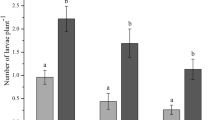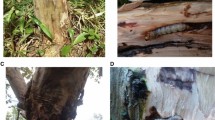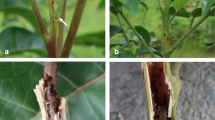Abstract
On-farm augmentative releases of the parasitoid Habrobracon hebetor (Say) for controlling the millet head miner (MHM) Heliocheilus albipunctella (de Joannis) were tested in Burkina Faso, Mali and Niger from 2007 to 2009. In addition, a survey of farmers’ perceptions of insect pests, with particular focus on MHM, and the biological control program (BCP) was carried out. There was a significant increase of MHM parasitization rate after the releases, with up to 97% mortality. The survey on farmers’ perceptions revealed a fair knowledge of the MHM and the ability of farmers to describe the pest and the damage it caused. Farmers claimed that the biocontrol agent H. hebetor is effective and perceived a significant gain in grain yield due to this control strategy. Implications of these findings for a large extension of the MHM biocontrol program are discussed.



Similar content being viewed by others
References
Bal, A. B., Kogo, S., Dankoulou, A., & Gagaré, S. (2002). Guide d'élevage et de lâchers de Habrobracon hebetor (Say) (Hymenoptera, Braconidae) parasitoïde de la chenille mineuse de l'épi de mil et de son hôte de substitution Corcyra cephalonica (Stainton) Lepidoptera, Pyralidae. Technical document. Niamey, Niger: AGRHYMET Centre.
Baoua, I., Bakabé, O., & Balla, H. (2002). Expérimentation d’un système de transfert de l’élevage de Habrobracon hebetor Say en milieu paysan: activités conduites dans la région de Maradi. Project DPV/INRAN/DFPV/ICRISAT report. Niamey, Niger: Ministère du Développement Agricole.
Bhatnagar, V. S. (1987). Conservation and encouragement of natural enemies of insect pests in dryland subsistence farming: problems, progress and prospects in the Sahelian zone. Insect Science and its Applications, 8, 791–795.
Bhatnagar, V. S. (1989). Lutte biologique contre la chenille mineuse de l'épi du mil. Sahel PV Info, 1–2, 5–8.
De Groote, H., Douro Kpindou, O. K., Ouambama, Z., Gbongboui, C., Müller, D., Attignon, S., et al. (2001). Assessing the feasibility of biological control of locusts and grasshoppers in West Africa: Incorporating the farmers’ perspective. Agriculture and Human Values, 18, 413–428.
Farag, M. M. A., Sayeda, S. A., & El-Husseini, M. M. (2012). Life history of Habrobracon hebetor Say (Hymenoptera: Braconidae) parasitizing Cadra (Ephestia) cautella (Walker) (Lepidoptera: Pyralidae) on dried date fruits. Egyptian Journal of Biological Pest Control, 22, 73–77.
Fujisaka, S. (1992). Will farmer participatory research survive in the international agricultural research centers? Gatekeepers Series 4. London, UK: International Institute for Environment and Development.
Gahukar, R. T., Guèvremont, T. H., Bhatnagar, V. S., Doumbia, Y. O., Ndoye, M., & Pierrard, G. (1986). A review of the pest status of the millet spike worm, Rhaguva albipunctella (de Joannis) (Noctuidae: Lepidoptera) and its management in the Sahel. Insect Science and Its Applications, 7, 457–463.
Garba, M., & Gaoh, N. B. (2008). Use of Habrobracon hebetor in biological control of Heliocheilus albipunctella pearl millet head miner. In: Proceedings of the 8th International Conference on Pests in Agriculture (pp. 436–444). Association Française de Protection des Plantes, INRA, Montpellier, France.
Heong, K. L. (1985). Systems and analysis in solving pest management problems. In B. S. Lee, W. H. Loke, & H. I. Heong (Eds.), Integrated pest management in Malaysia (pp. 133–149). Kuala Lumpur, Malaysia: MAPPS.
Krall, S., Youm, O., & Kogo, S. A. (1995). Panicle insect pest damage and yield loss in pearl millet. (pp. 135–145). In K. F. Nwanze, & O. Youm (Eds.), Proceedings of an International Consultative Workshop on Panicle Insect Pest of Sorghum and Millet. ICRISAT Sahelian Centre, Niamey, Niger.
Litsinger, J. A., Price, E. C., & Herrera, R. T. (1980). Small farmer pest control practices for rainfed rice, corn, and grain legumes in three Philippine provinces. Philippine Entomologist, 4, 65–86.
Montoya, P., Liedo, P., Benrey, B., Cancino, J., Barrera, J. F., Sivinski, J., et al. (2000). Biological control of Anastrepha spp. (Diptera: Tephritidae) in mango orchards through augmentative releases of Diachasmimorpha longicaudata (Ashmead) (Hymenoptera: Braconidae). Biological Control, 18, 216–224.
Morse, S., & Buhler, W. (1997). Integrated pest management ideas and realities in developing countries. London, UK: Lynne Riener Publishers.
Moser, R., Pertot, I., Elad, Y., & Raffaelli, R. (2008). Farmers’ attitudes toward the use of biocontrol agents in IPM strawberry production in three countries. Biological Control, 47, 125–132.
Ndoye, M. (1991). Biologie et dynamique des populations de Heliocheilus albipunctella (De Joannis) ravageur de la chandelle de mil dans le Sahel. Sahel PV Info, 39, 11–20.
Neuenschwander, P. (2003). Biological control of cassava and mango mealybugs in Africa. In P. Neuenschwander, C. Borgemeister, & J. Langewald (Eds.), Biological control in IPM systems in Africa (pp. 45–59). Wallingford, UK: CAB International.
Nwanze, F. K., & Harris, K. M. (1992). Insect pests of pearl millet in West Africa. Review of Agricultural Entomology, 80, 1133–1155.
Obrycki, J. J., Lewis, L. C., & Orr, D. B. (1997). Augmentative releases of entomophagous species in annual cropping systems. Biological Control, 10, 30–36.
Ochou, G. O., Matthews, G. A., & Mumford, J. D. (1998). Farmers’ knowledge and perception of cotton insect pest problems in Cote d’Ivoire. International Journal of Pest Management, 44, 5–9.
Ooi, P. A. C. (1996). Experiences in educating rice farmers to understand biological control. Entomophaga, 41, 375–385.
Overholt, W. A., Conlong, D. E., Kfir, R., Schulthess, F., & Setamou, M. (2003). Biological control of Gramineous Lepidopteran stem borers in sub-Saharan Africa. In P. Neuenschwander, C. Borgemeister, & J. Langewald (Eds.), Biological control in IPM systems in Africa (pp. 131–144). Wallingford, UK: CAB International.
Payne, W., Tapsoba, H., Baoua, I. B., Ba, N. M., N’Diaye, M., & Dabire-Binso, C. (2011). On-farm biological control of the pearl millet head miner: realization of 35 years of unsteady progress in Mali, Burkina Faso and Niger. International Journal of Agricultural Sustainability, 9, 186–193.
Poubom, C. F. N., Awah, E. T., Tchuanyo, M., & Tengoua, F. (2005). Farmers’ perceptions of cassava pests and indigenous control methods in Cameroon. International Journal of Pest Management, 51, 157–164.
Richards, M. O. W., & Thompson, W. S. (1932). A contribution to the study of the genera Ephestia Gn. (including Strymax dyar) and Plodia Gn. (Lepidoptera, Phycitidae), with notes on parasites of the larvae. Transactions of the Entomological Society of London, 79, 439–492.
Rowley, J., & Bennet, O. (1993). Grasshoppers and locusts. The plague of the Sahel. London, UK: The Panos Institute.
SAS. (2001). SAS version 8 for Windows. Cary, NC, USA: SAS Institute.
Sivinski, J. M., Calkins, C. O., Baranowsky, R., Harris, D., Brambila, J., Diaz, J., et al. (1996). Suppression of Caribbean fruit fly (Anastrepha suspensa (Loew) Diptera: Tephritidae) population through augmented releases of the parasitoid Diachasmimorpha longicaudata (Ashmead) (Hymenoptera: Braconidae). Biological Control, 6, 177–185.
Tamò, M., Ekesi, S., Maniania, N. K., & Cherry, A. (2003). Biological control, a non-obvious component of IPM for cowpea. In P. Neuenschwander, C. Borgemeister, & J. Langewald (Eds.), Biological control in IPM systems in Africa (pp. 295–309). Wallingford, UK: CAB International.
Tanzubil, P. B., & Yakubu, E. A. (1997). Insect pests of millet in northern Ghana. Farmers’ perceptions and damage potential. International Journal of Pest Management, 43, 133–136.
Tefera, T. (2004). Farmers' perceptions of sorghum stem-borer and farm management practices in eastern Ethiopia. International Journal of Pest Management, 50, 35–40.
Teng, P. S. (1987). The systems approach to pest management. In P. S. Teng (Ed.), Crop loss assessment and pest management (pp. 160–167). St. Paul, MN, USA: APS Press.
Yang, S., Yang, S. Y., Zhang, C. P., Wei, J. N., & Kuang, R. P. (2009). Population dynamics of Myzus persicae on tobacco in Yunnan province, China, before and after augmentative releases of Aphidius gifuensis. Biocontrol Science and Technology, 19, 219–228.
Youm, O., & Gilstrap, F. E. (1993). Life-fertility tables of Bracon hebetor Say (Hymenoptera: Braconidae) reared on Heliocheilus albipunctella (de Joannis) (Lepidoptera: Noctuidae). Insect Science and Its Application, 14, 455–459.
Youm, O., & Owusu, E. O. (1998). Assessment of yield loss due to the millet head miner, Heliocheilus albipunctella (Lepidoptera: Noctuidae) using a damage rating scale and regression analysis in Niger. International Journal of Pest Management, 44, 119–121.
Acknowledgments
This study was made possible through the support provided to INERA, IER and INRAN by the Collaborative Crop Research Program (CCRP) of the McKnight Foundation under the terms of grants No. 06–011 and Nos. 09–036 through −039. The opinions expressed herein are those of the authors and do not necessarily reflect the views of the CCRP/ McKnight Foundation. The authors are also thankful to farmers who graciously gave their time to answer and discuss questions, and to our collaborators, Adama Bonkoungou, Simon Tarpidiga, Mayaki Gaya, Laouali Amadou, Maimouna Abdourahamane, Ibrahim Ouattara and Amadou Tembely. We also thank Dr. David Onstad of the University of Illinois at Urbana-Champaign, USA, for his helpful editorial work.
Author information
Authors and Affiliations
Corresponding author
Rights and permissions
About this article
Cite this article
Ba, M.N., Baoua, I.B., N’Diaye, M. et al. Biological control of the millet head miner Heliocheilus albipunctella in the Sahelian region by augmentative releases of the parasitoid wasp Habrobracon hebetor: effectiveness and farmers’ perceptions. Phytoparasitica 41, 569–576 (2013). https://doi.org/10.1007/s12600-013-0317-x
Received:
Accepted:
Published:
Issue Date:
DOI: https://doi.org/10.1007/s12600-013-0317-x




